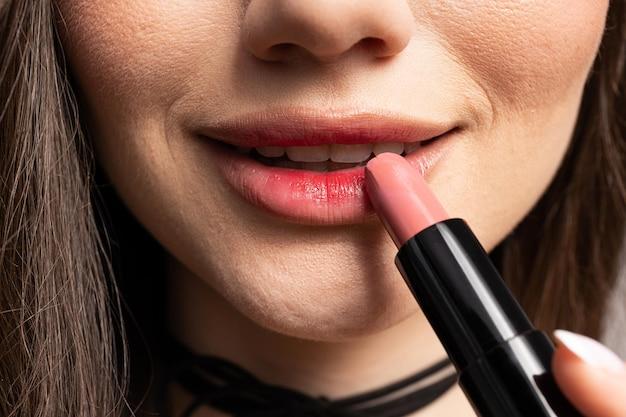Mica is a commonly used ingredient in cosmetics, known for its shimmering and reflective properties. It is widely used in a variety of products, including eyeshadows, highlighters, and lipsticks, to give them a luminous effect. However, there has been growing concern about the potential harmful effects of mica on the skin.
In this blog post, we will explore the various aspects of mica and its impact on the skin. From its usage in cosmetic products to its effects on different skin types, we will delve into the facts and address the common questions surrounding mica. So, if you’ve ever wondered about the safety of mica in your skincare routine or wanted to learn more about its alternatives, keep reading!
Is Mica Harmful To The Skin
Uncovering the Truth About Mica and Your Skin
When it comes to skincare, there’s always a lot of buzz around different ingredients. One such ingredient that has garnered attention in recent years is mica. But what exactly is mica, and should you be concerned about its effects on your skin? Let’s dive into this dazzling topic and separate fact from fiction, all while keeping our skincare routine on fleek!
The Marvelous World of Mica
Mica is a naturally occurring mineral that adds a touch of sparkle and shimmer to a wide range of beauty products. From eyeshadows that make your peepers pop to highlighters that give you that ethereal glow, mica has become a staple in the cosmetics industry. However, like any ingredient, mica has its pros and cons, so let’s dig deeper.
Mica and Your Skin: The Controversy Unveiled
Some concerns have been raised about the potential harmful effects of mica on the skin. While mica itself isn’t considered toxic, the controversy arises from the mining process. In certain regions, such as India, where mica is commonly sourced, there have been reports of child labor and unsafe working conditions. As conscious consumers, it’s essential to support brands that ethically source their mica to ensure these exploitative practices are not perpetuated.
It’s All About Balance
Putting ethical concerns aside, mica is generally safe to use in skincare products. It’s widely regarded as non-irritating and non-comedogenic, meaning it won’t clog your precious pores. So, if you’ve been using products containing mica and your skin has been gleaming like a goddess, no need to fret! Mica can enhance your natural beauty without causing harm.
Becoming a Savvy Shopper
Now that we know the ins and outs of mica, how can we make informed decisions when choosing skincare products? Look for labels that clearly state “ethically sourced mica” or “child labor-free mica.” By supporting companies committed to fair trade practices, we can contribute to positive change in the cosmetics industry, one shimmering highlight at a time.
Glowing and Growing
While mica isn’t inherently harmful to our skin, it’s essential to stay informed about the beauty industry’s ethics. By staying conscious of the source of our favorite sparkle-inducing products, we can radiate both beauty and compassion. So, let’s continue to educate ourselves, support ethical brands, and shine on, my skincare-loving friends!
Now you’re armed with the knowledge to navigate the world of mica and its impact on your skin. Remember, dazzle responsibly, and let your inner glow shine brighter than ever!
Keywords: is mica safe for skin, ethical sourcing of mica, mica and child labor, non-comedogenic mica, mica in skincare products, ethical beauty industry
FAQ: Is Mica Harmful To The Skin
Welcome to our comprehensive FAQ section on the topic of mica and its effects on the skin. We’ve compiled a list of common questions about mica in cosmetics and skincare to address any concerns you may have. So grab a cup of tea, sit back, and let’s dive in!
Why is Mica Used in Cosmetics
Mica is a naturally occurring mineral that adds shimmer, sparkle, and a luminous effect to cosmetics. It is commonly used in makeup products like eyeshadows, highlighters, and lipsticks to create a radiant and attractive appearance. Its light-reflecting properties make the skin appear more vibrant and youthful.
Does Milk Use Mica
No, milk doesn’t use mica. While milk does contain various beneficial nutrients for the skin, mica is not one of them. Mica is predominantly used in the beauty industry to enhance cosmetics’ visual appeal and does not have any direct connection to milk or dairy products.
What Companies Use Mica
Many cosmetic companies utilize mica in their product formulations. Some well-known brands that use mica in their cosmetics include MAC Cosmetics, L’Oreal, Maybelline, NARS, and Benefit Cosmetics. However, it’s important to note that mica is a common ingredient in a wide range of cosmetic products, both high-end and drugstore.
Is Mica Good for Sensitive Skin
For those with sensitive skin, mica is generally considered safe to use. However, individual reactions may vary, so it’s always recommended to do a patch test before applying any new cosmetic product to your face. If you experience any irritation or discomfort, it’s best to consult with a dermatologist.
Is Gold Mica Natural
Yes, gold mica is indeed a naturally occurring mineral. It is mined from the earth’s crust, making it a natural source of cosmetic pigmentation. Gold mica brings a beautiful golden hue to cosmetics and is a popular choice among makeup enthusiasts looking for a touch of glamour.
Can Mica Clog Pores
Mica itself is a non-comedogenic mineral, meaning it does not have pore-clogging properties. However, makeup products containing mica may sometimes include other ingredients that could potentially clog pores. To prevent any issues, it’s always a good idea to choose cosmetics labeled as non-comedogenic or oil-free if you have concerns about pore congestion.
Is Mica Non-Toxic
When used in cosmetics, mica is considered to be non-toxic and safe for use on the skin. It’s important to note that the mica used in beauty products goes through rigorous processing and purification before being included in formulations. However, as with any cosmetic ingredient, it’s essential to follow guidelines and use products as intended.
How Much Do Mica Miners Get Paid
Mica mining practices have evolved significantly to ensure fair wages and safe working conditions for miners. However, it’s essential to acknowledge that in some regions, unethical practices may still exist. Fair trade initiatives have been established to help improve the livelihoods of mica miners, ensuring they receive proper compensation for their work.
Is Mica Used in Skincare
Mica is primarily used in cosmetics rather than skincare products. Its light-reflecting properties are more beneficial for makeup formulations. However, some tinted moisturizers or BB creams may contain a small amount of mica to provide a subtle radiance to the skin.
Is Mica Dangerous to Health
When used as intended in cosmetics, mica is generally safe for use and not considered to be dangerous to health. However, there have been concerns regarding the mining practices associated with mica production, including potential occupational health risks for miners. It’s important for cosmetic companies to source mica responsibly and support ethical mining practices.
Is Mica a Safe Ingredient
Yes, mica is generally recognized as a safe ingredient in cosmetic formulations. Regulatory agencies, such as the Food and Drug Administration (FDA), have assessed and approved the use of mica in cosmetics. However, individuals with specific allergies or sensitivities should always check product labels and consult with a dermatologist if needed.
Does Mica Powder Stain Skin
Mica powder should not typically stain the skin. However, certain pigments used in combination with mica, such as deep blues or reds, may temporarily leave a slight stain. This can usually be removed with gentle cleansing. It’s always recommended to perform a patch test before using any new cosmetic product to observe any potential staining or adverse reactions.
Is Mica Bad for Oily Skin
No, mica is not inherently bad for oily skin. In fact, mica’s light-reflecting properties can help reduce the appearance of oiliness and create a more balanced and natural-looking complexion. However, it’s essential to choose oil-free or mattifying products if you have oily skin to prevent excess shine.
Does Urban Decay Use Mica
Yes, Urban Decay is one of the cosmetic brands that uses mica in its product formulations. Known for their bold and vibrant makeup, Urban Decay incorporates mica into eyeshadows, highlighters, and other products to achieve stunning finishes.
Is Mica Safe for Lips
Mica used in lip products, such as lipsticks and lip glosses, is considered safe for use on the lips. It is approved for cosmetic use and undergoes testing to ensure its safety. However, users with hypersensitivity or specific allergies should always read product labels and patch test if necessary.
What is an Alternative to Mica
Synthetic mica or mineral-based pigments can often serve as alternatives to natural mica in cosmetics. These alternatives provide similar visual effects without the concerns associated with mica mining practices. Some brands are shifting towards these alternatives to promote ethical and sustainable sourcing of cosmetic ingredients.
Is Mica Safe in Candles
Mica can be safely used in candles. However, it’s important to note that mica is primarily added for aesthetic purposes to create shimmering effects. As with any candle, it’s crucial to follow proper candle safety guidelines and trim the wick to prevent any potential hazards associated with open flames.
How is Mica Useful
Mica’s versatile properties make it useful in various industries, including cosmetics, paint, plastics, and electronics. Beyond its role in cosmetics, mica is utilized as insulation in electrical equipment, as a pigment in paints, and as a reinforcing agent in plastics. Its heat-resistant and electrical insulating properties make it invaluable in many manufacturing processes.
Why is Mica Bad
Mica itself is not inherently bad. However, concerns arise from the mining practices associated with its extraction. In some regions, mica mining has been linked to unethical labor practices, child labor, and unsafe working conditions. Efforts are being made to improve these circumstances and promote responsible sourcing of mica to mitigate these issues.
Is Mica the Same as Talc
No, mica and talc are two different minerals. Mica is a transparent mineral that provides shimmer and sparkle, while talc is a soft mineral known for its ability to absorb moisture and reduce friction. Both minerals are used in various industries but serve different purposes.
Is Mica Cancerous
There is currently no scientific evidence to suggest that mica causes cancer when used in cosmetics as directed. Mica used in beauty products undergoes rigorous testing to ensure its safety and compliance with regulatory standards. However, concerns about the mining practices associated with mica extraction have been raised, emphasizing the importance of responsible sourcing.
Is Mica a Clean Ingredient
The term “clean ingredient” can be subjective and varies depending on different sources and perspectives. Mica itself is a naturally occurring mineral, but concerns surround the labor and environmental practices associated with its extraction. If you prioritize clean beauty products, you may want to consider brands that prioritize ethical sourcing and transparent manufacturing processes.
What Does Mica Do to Your Skin
When used in cosmetics, mica provides a cosmetic effect by adding dimension, radiance, and a subtle glow to the skin. It reflects light, which can help reduce the appearance of fine lines and wrinkles and create a more youthful-looking complexion. Mica’s lightweight texture allows it to blend seamlessly into the skin, providing a natural and glowing finish.
And there you have it! We hope this FAQ section has answered your burning questions about the effects of mica on the skin. Remember, mica can add a touch of magic to your makeup routine, but it’s important to choose brands that prioritize ethical sourcing and responsible manufacturing processes. Stay radiant, stay informed, and always embrace your natural beauty!
Sourced: 2023

